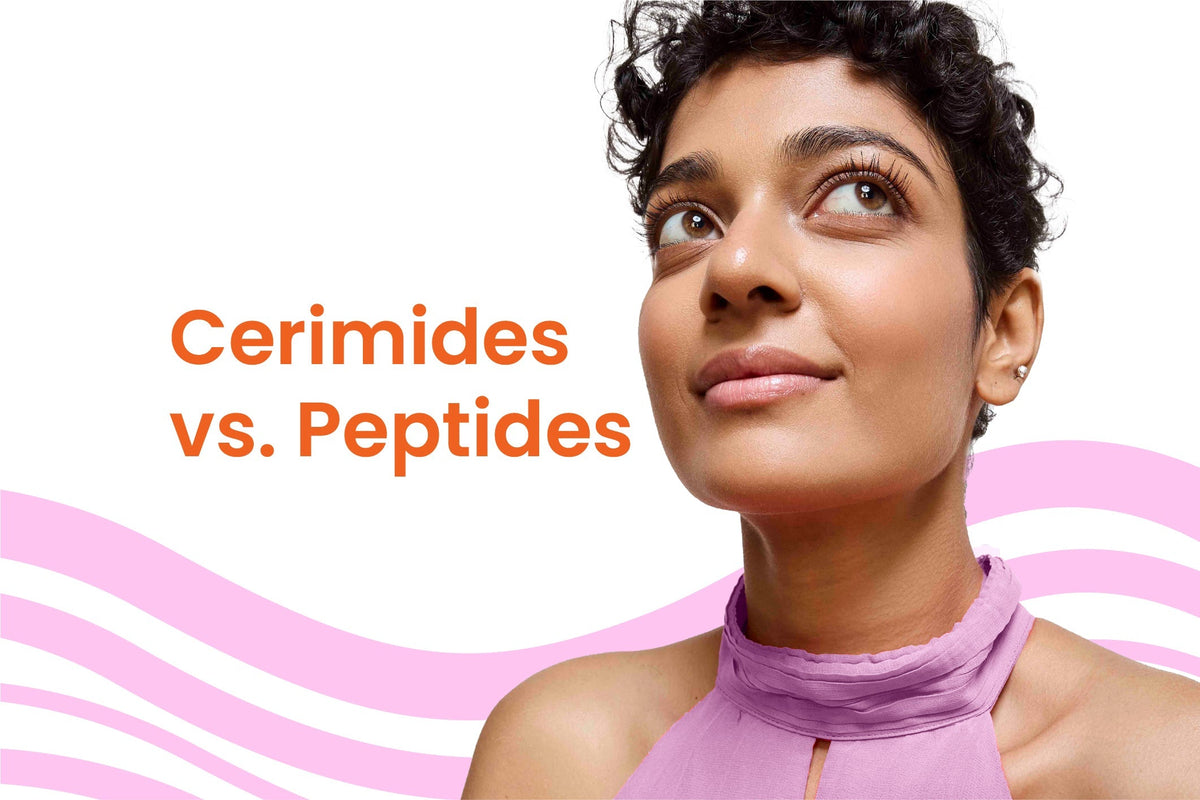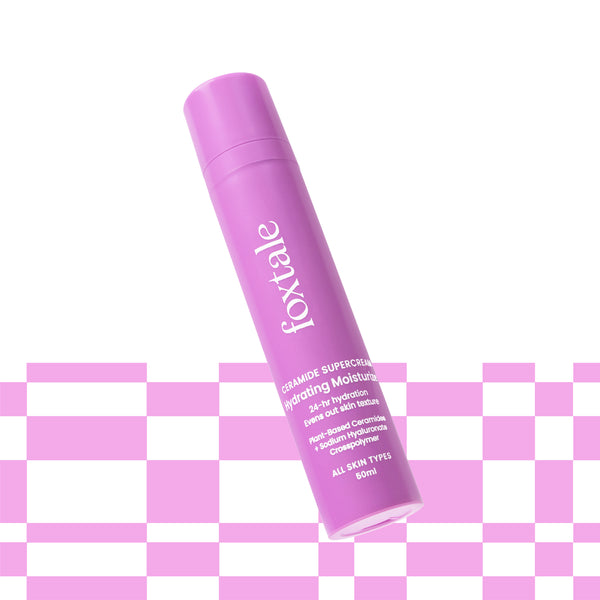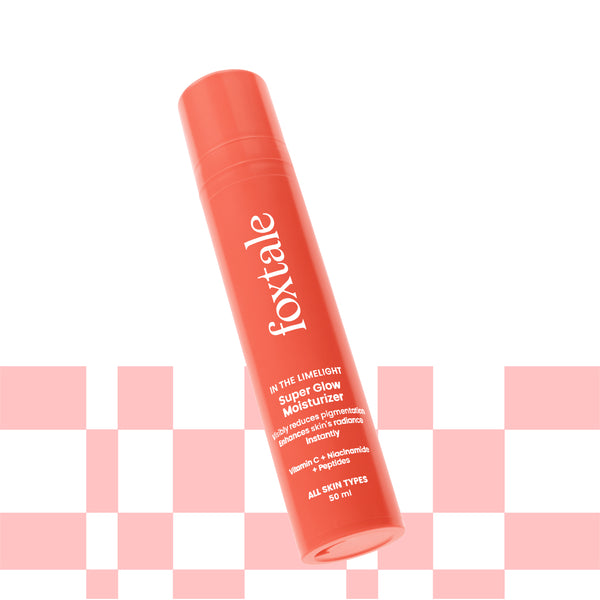
When it comes to skincare products, the ingredient list can sometimes feel like decoding a science experiment. Among the many buzzwords, Ceramides and Peptides stand out as two powerful players that often leave people wondering – what’s the difference? From strengthening your skin barrier to softening fine lines – they don’t just promise results, they deliver them. The key lies in understanding their unique roles and how they can work together to elevate your skincare routine. You’re in luck, because help is here.
What Are Ceramides for Skin?
Ceramides are lipid (fat) molecules that occur naturally in your skin. They account for almost half of your skin’s outer layer, serving as the “mortar” that holds your skin cells, the “bricks” in place. Their main job? Maintaining a healthy skin barrier and keeping moisture sealed in. Think of Ceramides as your skin’s bodyguards, protecting it from irritants, pollutants, and environmental stressors.
Some of its benefits include:
- Prevent dryness and flakiness by holding moisture in.
- Reduce irritation and sensitivity, making them perfect for compromised skin.
- Improve resilience, helping the skin recover from damage faster.
- Essential for conditions like eczema or very dry skin, where the skin barrier needs extra support.
What Are Peptides for Skin?
Peptides are short chains of amino acids – basically, mini-proteins. They serve as the building blocks for essential proteins like Collagen and Elastin, which are responsible for keeping your skin plump and smooth. Since natural Collagen levels drop with age, Peptides step in to remind your skin to keep producing these vital proteins.
Some of its benefits include:
- Smooth out fine lines and wrinkles.
- Improve skin texture, giving a firmer, bouncier appearance.
- Support wound healing and skin renewal.
- Enhance overall elasticity, making skin look more youthful.
Ceramides vs Peptides: Key Differences at a Glance
|
Aspect |
Ceramides for Skin |
Peptides for Skin |
|
Primary Function |
Strengthen skin barrier, retain moisture |
Stimulate Collagen & Elastin production |
|
Anti-Aging Benefits |
Indirect (prevents premature aging by protecting barrier) |
Direct (reduces wrinkles, boosts firmness) |
|
Skin Barrier Support |
Excellent |
Minimal |
|
Hydration |
Deep hydration, prevents water loss |
Limited, but improves plumpness |
|
Skin Types |
Ideal for dry, sensitive, or irritated ski |
Ideal for aging, dull, or uneven-textured skin |
|
Compatibility with other actives |
Works well with most (Retinol, Vitamin C, Hyaluronic Acid) |
Generally safe, but works best with hydrating or barrier-repair ingredients |
Can You Use Ceramides and Peptides Together?
Absolutely! Ceramides and peptides don’t just get along – they complement each other beautifully. While the former repairs and protects the outer layer, the latter works underneath to boost Collagen and elasticity. Together, they’re the ultimate duo your skin has been waiting for.
Application Tips:
- Use a Peptide serum first (on clean skin).
- Follow up with a Ceramide-rich moisturizer to lock everything in.
- Gentle and effective, they can be used every day, AM and PM.
For best results, try pairing a Peptide serum with a Ceramide moisturizer. If you prefer a simpler routine, look for hybrid formulas that combine both ingredients in one product, giving you double the benefits without the extra steps.
Choosing the Right Ingredient for Your Skin
If your skin feels tight, dry, itchy, or is prone to redness, Ceramides should be your go-to. They’re especially helpful if your skin barrier is damaged from over-exfoliation, harsh products, or environmental stress.
Benefits
- Restores hydration
- Repairs the skin barrier
- Calms irritation and sensitivity
A great pick: the Hydrating Moisturizer with Ceramide, your skin’s very own protective shield. It not only locks in moisture but also helps repair damage from pollution and harsh skincare routines. Bonus: it delivers deep hydration that lasts up to 24 hours.
If you’ve started noticing fine lines, sagging, or dullness, Peptides will be your best friend. They target the deeper concerns of aging by boosting Collagen production.
Benefits
- Promotes firmness and elasticity
- Softens wrinkles and fine lines
- Improves overall skin texture and bounce
A great option: the Super Glow Moisturizer with Vitamin C, which blends Peptides with brightening activities like Vitamin C. This dual-action formula not only improves skin’s firmness but also enhances radiance, leaving you with a healthy glow. The best part? Thanks to its lightweight, quick-absorbing formula, it’s perfect for layering under your daytime products.
Conclusion
The best part about Ceramides and Peptides? You don’t have to pick sides. Using them together can give your skin the ultimate care package: protection, hydration, and age-defying benefits. So, whether your concern is dryness, sensitivity, or the first signs of aging, Ceramides and Peptides are two ingredients worth making room for in your beauty shelf.
FAQs
1. What are Collagen Peptides?
Collagen Peptides are short chains of amino acids derived from Collagen, the protein responsible for skin’s strength and elasticity. When applied topically or taken as a supplement, they signal the skin to produce more Collagen, helping reduce fine lines, improve firmness, and maintain a youthful texture.
2. Is Ceramide good for oily skin?
Yes! Ceramides are not heavy or pore-clogging, making them suitable for oily skin as well. They work by strengthening the skin barrier and locking in moisture, which can actually help regulate excess oil production. Properly hydrated skin is less likely to overcompensate by producing more sebum.
3. Do Ceramides cause acne?
No, Ceramides are generally non-comedogenic, meaning they don’t clog pores. In fact, they can help calm irritated, sensitive, or acne-prone skin by repairing the skin barrier and reducing inflammation. However, always check the full formulation of a product, as other ingredients could potentially trigger breakouts.
4. Do Ceramides or Peptides go first?
Typically, peptides go first, especially if they’re in a serum, followed by Ceramides in a moisturizer. Peptides target Collagen production, whereas Ceramides lock in moisture and reinforce the skin’s protective layer. Layering them this way ensures you get the best of both worlds.





